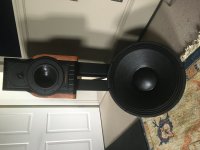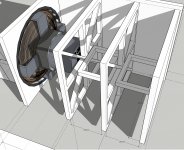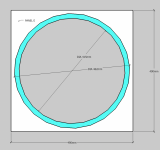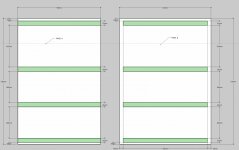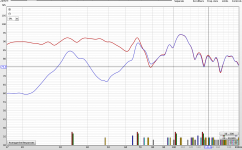No, it won't be that driver - Wharfedale say their cab uses a 4" voice coil rather than the 2.5" of the Eminence.
No, it won't be that driver - Wharfedale say their cab uses a 4" voice coil rather than the 2.5" of the Eminence.
Yes it seems to have higher power handling and max SPL but I assume that depends on the use of subsonic filters at say 40Hz. Any decently priced 18” PA drivers suited for such an application? Small box, high power from 30-40Hz? The eminence drivers looks ok with its low Fs on the paper and reviews are good and it’s tailored for small box but I’m a little sceptic looking at the magnet. I think I’d preferred a neo magnet and a few more watts.
Assuming you wish to replace the driver that bracing setup might be limiting. I’d do it differently bracing front to back with a half circle cut out and then brace to the remaining side walls if wanted.
True but I think most 18's other than the car audio based designs will probably. The B&C has a different bolt circle just to be annoying as well, I might want to tweak the box size I think the box is probably going to be 1/2-2/3 the costs of an exotic driver
But wouldn’t it be easier to just have a circular cutout on the bracing a? Same cutout as the driver itself? Then a few back to front braces of 18x4x2cm between each, maybe two per section per wall total of 24? My point is to stiffen the front.
107dB at 20Hz in 100 litres... Nice reference, but expensive.
I have built two of these for a friend who built them into recesses he made each side of his screen in a home cinema build.
He calls them "limitless" and powers them with class D power amps, quite small in size but powerful, Hypex or ICE power I think.
The whole system is Eq'd with a DSP crossover.
The only downside is the £ cost of the driver, but to be honest its money well spent as the sound is astonishing. Plus the reliability which comes from Precision Devices R&D plus countless real world live sound installations running it with massive power amps.
I have built two of these for a friend who built them into recesses he made each side of his screen in a home cinema build.
He calls them "limitless" and powers them with class D power amps, quite small in size but powerful, Hypex or ICE power I think.
The whole system is Eq'd with a DSP crossover.
The only downside is the £ cost of the driver, but to be honest its money well spent as the sound is astonishing. Plus the reliability which comes from Precision Devices R&D plus countless real world live sound installations running it with massive power amps.
Attachments
I have built two of these for a friend who built them into recesses he made each side of his screen in a home cinema build.
He calls them "limitless" and powers them with class D power amps, quite small in size but powerful, Hypex or ICE power I think.
The whole system is Eq'd with a DSP crossover.
The only downside is the £ cost of the driver, but to be honest its money well spent as the sound is astonishing. Plus the reliability which comes from Precision Devices R&D plus countless real world live sound installations running it with massive power amps.
Precision Devices are not the most hifi sounding pro audio drivers. They are popular in scoop horns because they can take a beating and go hard and low, but they don't sound that good. B&C makes much better drivers for that kind of money, also in 21".
But wouldn’t it be easier to just have a circular cutout on the bracing a? Same cutout as the driver itself? Then a few back to front braces of 18x4x2cm between each, maybe two per section per wall total of 24? My point is to stiffen the front.
The front panel is countersunk on all edges by 5mm, which will hold the front panel very rigidly and if you look there really isn't much material left to flex, 25mm birch ply is stiff. If the front baffle was to think about flexing it is pinned very tightly with the edge detail
Attachments
Going to buy some Poly and use this as the basis for wadding level GlassWolf's Pages
any advice on this would be appreciated and I also wondered if applying any internal bitumen based panel damping has ever been considered ? (will make it heavier I know !)
any advice on this would be appreciated and I also wondered if applying any internal bitumen based panel damping has ever been considered ? (will make it heavier I know !)
The front panel is countersunk on all edges by 5mm, which will hold the front panel very rigidly and if you look there really isn't much material left to flex, 25mm birch ply is stiff. If the front baffle was to think about flexing it is pinned very tightly with the edge detail
I might add some of these for complete overkill
Attachments
There aren't many real bad 18 inch woofers out there.
One thing, if it is going to be a subwoofer, I hope you're going to feet it actively with an active filter.
If so, the comparisons earlier in this thread don't say an awful lot.
Basically you just have to look at cone excursion, Qts and VAS.
Anything else can just be corrected in your active filters.
Next is applying these filters to the response you want (roughly, it's a starting figure) and see how much power they need.
How much power it needs is a bit more complicated than just frequency and volume, it highly depends on the Qts and VAS of de speaker (and a couple of other factors)
What I am mostly missing, is a budget.
I can name a thousand good 18 inch subs.
I wouldn't go much lower than 25-30Hz -3dB or 20Hz -6dB.
Going lower will just stress the amps as well as the woofer, and there is plenty of room-gain available at that point.
Oh, and if there is a 4ohm version available, I would go for that.
It is just much easier to find an amp that can deliver the voltage.
(most amps are rated on 4ohm, so you will lose half the power at 8 ohm)
In subwoofers you don't need any damping material.
In fact, they will only provide additional non-linear behavior.
One thing, if it is going to be a subwoofer, I hope you're going to feet it actively with an active filter.
If so, the comparisons earlier in this thread don't say an awful lot.
Basically you just have to look at cone excursion, Qts and VAS.
Anything else can just be corrected in your active filters.
Next is applying these filters to the response you want (roughly, it's a starting figure) and see how much power they need.
How much power it needs is a bit more complicated than just frequency and volume, it highly depends on the Qts and VAS of de speaker (and a couple of other factors)
What I am mostly missing, is a budget.
I can name a thousand good 18 inch subs.
I wouldn't go much lower than 25-30Hz -3dB or 20Hz -6dB.
Going lower will just stress the amps as well as the woofer, and there is plenty of room-gain available at that point.
Oh, and if there is a 4ohm version available, I would go for that.
It is just much easier to find an amp that can deliver the voltage.
(most amps are rated on 4ohm, so you will lose half the power at 8 ohm)
In subwoofers you don't need any damping material.
In fact, they will only provide additional non-linear behavior.
Last edited:
The set up is via a 10x10 Mini DSP which has active filters, it will be 8 channels in (run in parallel) so all apart from LFE to direct to amps that drive the main channels as well as to the Mini DSP so I can then add the missing frequencies for each surround and not need to roll off or EQ the bass in the main channels
Here is an example of a front channel, red is main with the connection to the DSP in parallel, blue is front channel only. I use filters on the input for each channel so when I add EQ'd subs I can remove the bump in the front channel , in this case at 34 Hz. I live with any peaks beyond 60Hz as I don't want to EQ the channels with active filters I prefer room control for everything apart from subs. Adding a 4th sub will hopefully provide a more even response so I can reduce some EQ with the three subs and also provide something below 17 Hz. My 3 existing subs use 12" drivers
Here is an example of a front channel, red is main with the connection to the DSP in parallel, blue is front channel only. I use filters on the input for each channel so when I add EQ'd subs I can remove the bump in the front channel , in this case at 34 Hz. I live with any peaks beyond 60Hz as I don't want to EQ the channels with active filters I prefer room control for everything apart from subs. Adding a 4th sub will hopefully provide a more even response so I can reduce some EQ with the three subs and also provide something below 17 Hz. My 3 existing subs use 12" drivers
Attachments
Precision Devices are not the most hifi sounding pro audio drivers. They are popular in scoop horns because they can take a beating and go hard and low, but they don't sound that good. B&C makes much better drivers for that kind of money, also in 21".
Is your opinion based on any credible AB testing ie http://www.humblehomemadehifi.com/download/Humble Homemade Hifi_Serious Sub.pdf
Or published Pro magazines ie Sound on Sound?
Or by suitably qualified technical experts from credible AES recognised sources? If so please post links.
If not... Its just your opinion and thats fine. We are all entitled to an opinion, but in order to help forum members benefit from your opinion some frame of reference is helpful, thanks.
My own frame of reference covers the last 30 years or so from Wilmslow Audio Vortex kit (passive two way with 10 inch Volt bass/mid plus Morel dome) to large three way active DSP open baffle and sealed box designs (never ported/TL or back loaded horns... Yuk!).
I have enjoyed good results from Volt, Beyma, 18 Sound, Celestion and Precision Devices Pro drivers. Plus, Manger, Scan Speak, Seas, Audax and Morel. Prob more that I have forgotten.
Highlights of drivers:
For the 20Hz to 80 Hz band Precision devices 15 and 18 inch drivers are easily the best.
Honourable mention goes to Beyma for the SM115K which is great value.
For 80Hz to 500 Hz the Precision Devices PD158 is again unmatched by anything else I have heard or used.
Honourable mention to Beyma 15 P80 Fe/N which is also great value.
The 12 inch version is also fab LOUDSPEAKER 12"P80/Fe V2 8 OH
Also a forgotten gem is the superb 10 inch Volt 2500.4 which sounds great but measures poorly. Volt Loudspeakers | BM2500.4 (10″)
The smallest bass/mid driver I have used that I really like is the Eighteen Sound - Professional loudspeakers
My personal listening preferences include the ability to hit low distortion life like dynamics (real vocals and piano hit 115dB peaks in music rooms or typical studio live rooms), accurate tone and a well balanced frequency response which can be Eq'd to match room acoustics as I have found this a key factor in high performance home audio.
Hope this helps.
...real vocals and piano hit 115dB peaks in music rooms...
At what distance?
- Home
- Loudspeakers
- Subwoofers
- 18" sealed sub of modest dimensions

